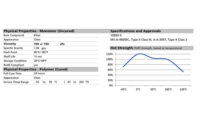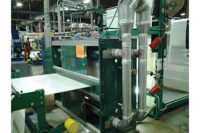Mobility trends point to the expanded use of sensors, cameras, and electronic controls in vehicle assembly. All of these elements will minimize the need for a driver’s physical control when operating a motor vehicle in the not-too-distant future. All in all, vehicle assemblies will be very similar to the components of a cell phone—just a lot more numerous.
Beyond Lightweighting
The adhesive industry is already enjoying the benefits of the trend toward vehicle lightweighting. New and dissimilar substrate materials bonded with high-performance adhesives naturally lend themselves to lightweighting compared to other fastening techniques. This continuing trend will account for a significant portion of the increasing volume of adhesives used in light-duty vehicles.
Recently, as part of our research, we looked into how adhesive usage might vary between internal combustion engines (ICs) and electric vehicle (EV) drivetrains. Generally speaking, the similarities of adhesive and sealant use in ICs and EV motors are actually greater than the differences. Both systems have mechanical assemblies like bearings and gears that are retained with adhesives; threaded fasteners that are subject to vibration and thermal cycling, necessitating adhesive augmentation; and systems that require sealing against fluid migration, dust, and air flow.
Since I am still painting with a broad brush, an EV drivetrain isn’t dramatically different from other electric motors that have been built for a century. The primary differences of the EV motor lie in scale, environment, and source of electricity.
Sealing In vs. Sealing Out
I characterize IC and EV differences as sealing in substances vs. sealing them out. That is a statement full of holes requiring clarification, but it is not too far off as a summary. In addition to holding together parts in the harsh automotive environment, IC drivetrain applications focus on sealing in coolants, fuel, lubricants, and air/gases while simultaneously keeping contaminants out. With the exception of coolant applications that are similar to ICs, EVs block moisture, water, air, dust, and other contaminants out of the system.
Comparing a standard IC engine lead-acid cell battery to the most common lithium-ion batteries used in EV reveals yet another fascinating divergence of functionality: sealing in the acid-based electrolyte is the primary function of materials used for lead-acid batteries, while sealing out moisture is critical for lithium-ion batteries.
An EV motor’s temperature rating may be higher than other motors such as those for windshield wipers and air movement fans in ICs, yet it is still well within range of most reactive adhesive chemistries, and thus not a particularly high barrier. Most of these applications are well-known to industry suppliers. With the exception of batteries, many of them occur in captive, Tier 1 plants.
Hidden Value Drivers
When we shift our focus to a car’s sensors, cameras, and electronic controls, we see that these elements bear little (if any) resemblance to the OEM assembly of the vehicle. A change in manufacturing processes is evident from the start—these car parts more closely resemble the electronic assemblies found in computers, tablets, smartphones, and high-end optical devices.
Smaller quantities of adhesives are applied more discreetly in these applications, compared to body assembly and many drivetrain applications. The customer base will pull through unique performance criteria and drive up value. Thermally conductive products are vital, as advanced technology is packed into smaller spaces and is expected to perform in the demanding environment of light vehicles. Add to these high-performance demands the potential that failure may be catastrophic (e.g., autonomous and safety support systems), and the criticality rises exponentially.
Electrically conductive adhesive use is rising as fine spacing, environmental restrictions, and new materials impact or replace assembly methods using solder, brazing, welding, or sintering. Protecting all these systems in use is increasing the need for conformal coatings and encapsulants at a time that many of us expected a decline in use. Smaller boards and discrete protection have been offset by the increase in devices. Optical assemblies are driving high-value adhesives that provide fast cure or positioning and optical clarity.
Future Innovation
These mobility trends are, of course, driving volume demand, which in and of itself is good news for the adhesives and sealants industry. Less measurable, but equally important, is the fact that the pressure on technology will enhance performance criteria in other industries.
The requirement for adhesive manufacturers to raise the performance bar relative to thermal conductivity, electrical conductivity, durability in harsh environments, optical clarity, and cure speed will further drive innovation. Those same drivers will push advances by the supply base working in nanomaterials, energy-efficient cures, and worker-safe chemistries. Consider the megatrend of cradle-to-cradle sourcing driving innovation in reuse and reclamation, and it all adds up to an exciting time in the adhesives and sealants industry.



